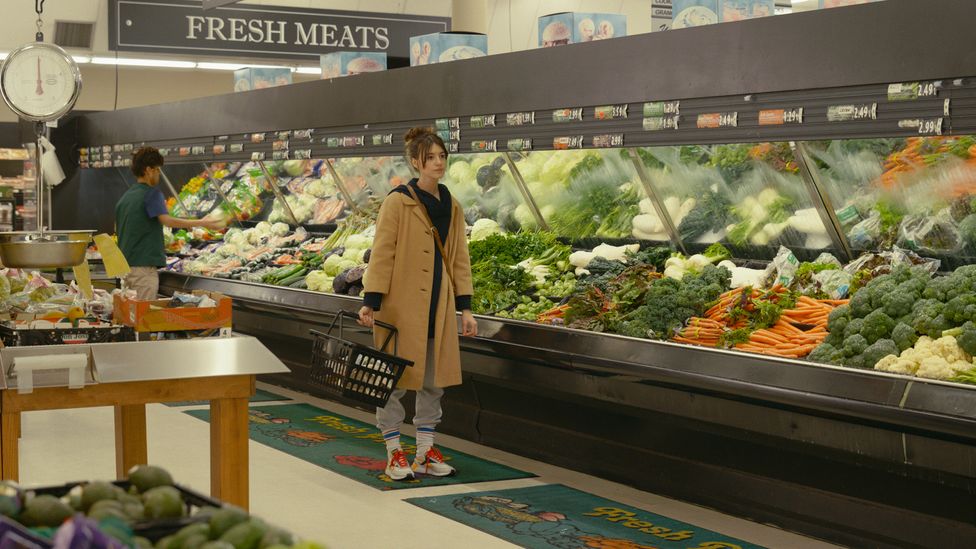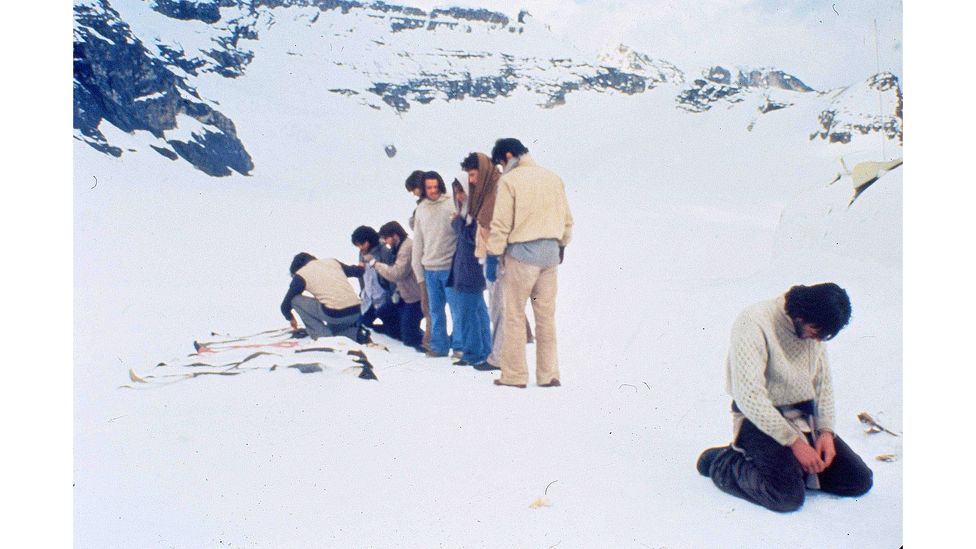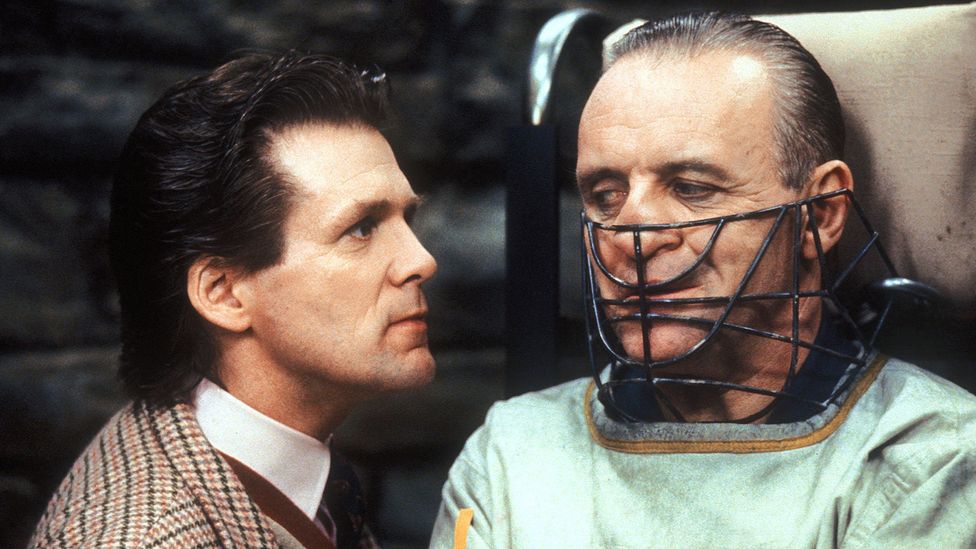Is this the greatest taboo of all?

The latest film from Luca Guadagnino, the director of Call Me by Your Name, seems at first to be the story of an ordinary American teenager. Having enrolled in a new school, Maren (Taylor Russell) is happy to be invited to a sleepover at another girl’s house. She is happy, too, to chat and gossip with her prospective friends. But later in the evening, when her hostess shows off her varnished nails, Maren pulls the girl’s finger into her mouth and bites down with a horrible crunch. Maren, it turns out, has a highly unconventional diet. And over the course of Bones and All, adapted from the 2015 novel by Camille DeAngelis, she learns that she isn’t alone. In Maren’s world, cannibals are everywhere.
More like this:
– The X-rated cartoon that shocked the US
– The most disgusting films ever made
– The horror that demonized older women
That’s true beyond Bones and All. Earlier this year, Fresh was released on Disney+, with Daisy Edgar-Jones as Noa, a young woman tired of today’s dating scene, and Sebastian Stan as the handsome surgeon who seems to be her ideal man – at least until he announces that he is going to chop her up and sell her to a network of gourmands. And another television drama, Yellowjackets, brought the suggestion of cannibalism into its tale of high-school cheerleaders lost in the wilderness.
As different as these films and series are, they all trade on the unique, stomach-churning, spine-chilling discomfort that comes from the thought of humans eating humans. Historically, cannibalism is the ultimate taboo – the line that can’t be crossed. What distinguishes it from other types of on-screen nastiness is that it disgusts us in two separate ways – in other words, the prospect of being eaten is nightmarish, but the prospect of doing the eating is almost as bad. Julie Taymor’s Titus (1999), Peter Greenaway’s The Cook, the Thief, His Wife and Her Lover (1989), and Tim Burton’s Sweeney Todd: The Demon Barber of Fleet Street (2007) all play on the latter fear. In Fresh, Noa’s escape plan depends on her sampling some meat that might just have been sliced from her own torso. “Is this… me?” she asks, as she prepares to take her first mouthful.

Earlier this year, Daisy Edgar-Jones starred in Fresh, one of several recent films and series to approach the topic of cannibalism (Credit: Searchlight Pictures)
The question of why anyone else would eat a human underpins all cannibal films. One dubious answer presented by early examples of the genre, is that cannibalism is standard practice in certain corners of the globe. The word “cannibal” is derived from “Carib”, an ethnic group that also gave its name to the Caribbean. Christopher Columbus and other Spanish conquistadors reported that the Caribs dined on roasted human flesh, and colonial people-eating lore was soon well established: the cannibalistic Queequeg is one of the main characters in Herman Melville’s Moby-Dick. By the 20th Century, racist tropes of pith-helmeted white explorers being dunked in cooking pots had become a staple of comic strips, cartoons and comedies: Betty Boop, Mickey Mouse and Bugs Bunny all took their turns in the soup – although whether it counts as cannibalism when a mouse and a bunny are involved is a matter for debate – as did Abbott and Costello in Africa Screams (1949).
A grittier update of this trope can be seen in Ruggero Deodato’s infamous Cannibal Holocaust (1980), a found-footage shocker with such convincing bloodshed that the director had to go on television with his actors to prove that he hadn’t murdered them. “It does look like the real thing,” says Barry Forshaw, who recorded a commentary for the Blu-ray of Cannibal Holocaust. “It doesn’t look phoney at all. Deodato uses the loathsome tactic of showing real animals being killed on screen in order to establish to the audience that anything goes in his film. Later, when you see the actors chewing bits of something from the local butcher, you can believe it’s human flesh.”
Cannibal Holocaust is just one of many Italian films of the 1970s and 1980s that have white Europeans venturing into jungles and risking being the main ingredient of a nutritious stew. And Calum Waddell, whose documentaries include Eaten Alive! The Rise and Fall of The Italian Cannibal Film (2015), and Searching for Cannibal Holocaust (2021), has managed to watch them all. “The trend draws from what author Eric Schaefer dubs the ‘atrocity’ and ‘exotic’ films of the 1930s and 1940s,” he tells BBC Culture, “which highlighted an imperialistic perspective towards Europe’s foreign colonies, particularly in Africa. If you look at such films as Ingagi [1930] and later offerings like Mau Mau [1955], along with more well-known works, such as King Kong [1933] and the Tarzan movies, you can see where Italian cannibal films came from.
“These films are incredibly racist,” Waddell says. “They have the concept of the ‘great white hunter’ encountering a ‘savage, primitive people’. They have Orientalist tropes such as the ‘exotic girlfriend’. In the first Italian cannibal film, The Man from Deep River [1972] and its follow-up Last Cannibal World [1977], the white European hero attracts the lust and love of a beautiful local female. To be honest, the fact that the on-screen cannibals eat other humans is the least problematic thing about them.”

Frank Marshall’s Alive (1993) tells the true story of rugby players who were stranded in the Andes after a plane crash in 1972 (Credit: Alamy)
But cinematic fantasies about “savage, primitive people” making a meal of their fellow men and women aren’t confined to any one region. Two Thousand Maniacs (1964), The Texas Chain Saw Massacre (1974) and The Hills Have Eyes (1977) are all set in isolated US backwaters, while Soylent Green (1973), A Boy and His Dog (1975) and The Road (2009) are all set in dystopian futures. Anywhere that resources are scarce, and society’s rules don’t apply, can be a home to cannibals. Even Bones and All makes a point of keeping Maren in small towns on the fringes of civilisation. Similarly, there are fact-based dramas which show that any of us might rethink our vegetarianism if conditions were extreme enough. Frank Marshall’s Alive (1993), one of the inspirations for Yellowjackets, tells the true story of the rugby players who were stranded in the Andes after a plane crash in 1972. “I still think the most upsetting moment of cannibalism in screen history is in Alive,” says Waddell, “where the characters decide to eat one of their dead friends in order to survive a little longer. I find that more upsetting than any of the flesh-munching in Cannibal Holocaust.”
Between fact and fantasy
A curious paradox, though, is that another strain of films takes the opposite approach to its cannibal characters. In this category, people don’t tuck into each other because they are destitute or savage, but because they are wealthy and refined, and they see human flesh as a delicacy. But maybe these strains aren’t so far apart. Maybe the human-flesh-as-delicacy conceit expresses a suspicion that the super-rich are just as distant from societal norms as the caricatured outsiders in The Hills Have Eyes and Last Cannibal World. At both extremes, cannibalism is used to signify that some people are beyond the pale – that for them, nothing is off the table.
A key text in human-flesh-as-delicacy studies is Stanley Ellin’s short story, The Specialty of the House, which was published in 1948. Its setting is an exclusive Manhattan restaurant which serves its lucky diners “lamb Amirstan” (spoiler: it’s not lamb). The story was adapted as an episode of the Alfred Hitchcock Presents television series in 1959, and ever since, such unorthodox fine dining has been used to satirise the powerful’s predatory exploitation of the powerless. As the poster advertising the film Society (1989) puts it: “The rich have always fed off the poor. This time it’s for real.”
The idea has been revived in Fresh, in which Stan’s evil surgeon boasts that he caters for “the one per cent of the one per cent” who can afford $50,000 for a plate of minced homo sapiens. But the conceit will always be embodied by Hannibal Lecter, the snobbish aesthete who remarks in The Silence of the Lambs (1991) that he ate a census taker’s liver “with some fava beans and a nice Chianti”. Dr Lecter may be known as “Hannibal the Cannibal”, but initially his unusual taste in haute cuisine was just one of many traits. “But it’s become a character-defining thing,” says Forshaw, who wrote the Devil’s Advocate guide to The Silence of the Lambs (2013). “It’s like Arthur Conan Doyle mentioning cocaine and violin-playing in the Sherlock Holmes stories, and those becoming things that everyone remembers. Audiences were so excited by Lecter’s cannibalism that Thomas Harris [the author of the novels] ran with it. He makes it a plot point in Hannibal when the FBI man [played by Ray Liotta in Ridley Scott’s 2001 film] is served his own brains for dinner. My wife can’t watch that scene. I remind her that they’re using visual effects, and they haven’t really sawed open Ray Liotta’s cranium, but she still walks out of the room.”

The concept of human-flesh-as-delicacy is embodied by Hannibal Lecter, played by Anthony Hopkins in the 1991 film The Silence of the Lambs (Credit: Alamy)
The strange thing is that the you-are-what-you-eat scene in Hannibal undoubtedly has what Waddell calls “the ick factor” – but it also prompts queasy laughter. Certain kinds of violence may be unambiguously distressing to see, but Lecter’s cranial canapés make audiences chuckle. At the end of The Silence of the Lambs, he bids Clarice (Jodie Foster) a suave farewell: “I do wish we could chat longer, but I’m having an old friend for dinner.” If he’d said he was going to torture and murder that “old friend”, it would have been abhorrent – but because the audience knows he’s planning to eat Dr Chilton (Anthony Heald), possibly with a nice Chianti, some embrace him as a devilish anti-hero.
Why can cannibalism be more humorous than other such outrages? “It should be the most unspeakable human crime,” explains Forshaw, “but it’s so alien to anything we know that we’re not sure how to react.” Cannibalism in films is unique because it sits right on the border between fact and fantasy, between the everyday violence of a crime thriller and the supernatural violence of a monster movie. It may happen in the real world, but it’s so rare and so appalling that it seems like the stuff of legend – so it can be terrifying and loathsome, but funny, too. For instance, Sweeney Todd: The Demon Barber of Fleet Street features a witty duet in which Sweeney and Mrs Lovett discuss which professions make the tastiest pie fillings. And Forshaw’s favourite line on the topic comes from a 1976 comedy, The Big Bus: “You eat one lousy foot and they call you a cannibal. What a world!”
What’s even weirder is that some cannibal films don’t just have comic aspects, but erotic aspects, too. Bones and All and Fresh both revolve around cool, sexy characters played by pin-up actors, as does Julia Ducournau’s Raw (2016). All of these films ponder the link between loving someone and feasting on them, between cannibalism and kinks and body modification. And, let’s not forget, one of these films is available on Disney’s own streaming service. Who knows, perhaps the ultimate taboo won’t be taboo for much longer.
Bones and All is released on 22 November.
Love film and TV? Join BBC Culture Film and TV Club on Facebook, a community for cinephiles all over the world.
If you would like to comment on this story or anything else you have seen on BBC Culture, head over to our Facebook page or message us on Twitter.
And if you liked this story, sign up for the weekly bbc.com features newsletter, called The Essential List. A handpicked selection of stories from BBC Future, Culture, Worklife and Travel, delivered to your inbox every Friday.








